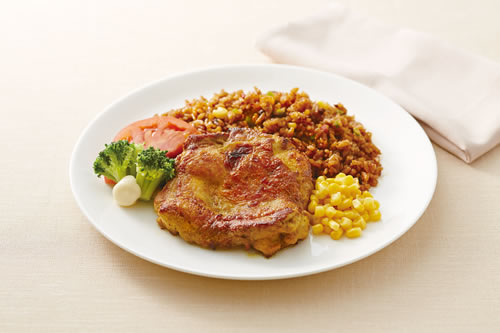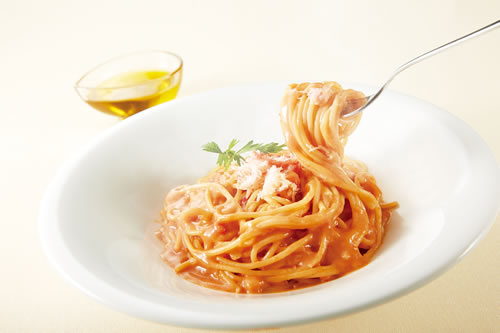[From August Issue 2015]
Following on from “rekijo” – women who like history – in recent years there are more and more “touken joshi,” that is women interested in swords. There are many kinds of swords in Japan. It’s said that this trend was kick-started by a video game. The swords in the game take the form of attractive young men and many women became fans for this reason.
The Tokugawa Art Museum, in Nagoya City, Aichi Prefecture, houses numerous famous swords. Up until now this museum used to mainly be visited by elderly men. But recently more and more women in their 20s and 30s are visiting the museum. “I think women have come to be fascinated by swords because they’ve entered pop culture through video games,” says YOSHIKAWA Yuki, a member of staff at the museum.
While swords are attractive artistic objects, besides their beauty, so-called famous swords also have historical tales behind them. For example, according to legend, “Katana Mei Muramasa” brought bad luck to the Tokugawa family; this sword has appeared in many games and novels and is popular nationwide. “The unique crest on the blade creates a mysterious mood and its charm draws you into its legend,” says Yoshikawa.
“I got into swords through video games and have discovered the charms of actual swords,” says NAKANE Tomoko, a sword fan. Nakane travels by night bus to visit museums all over Japan and see their swords. Sometimes she goes to the same museum three days in a row.
Besides their aesthetic charms, there are other ways to enjoy swords. As well as giving Skype-based “Samurai Experience Lessons” to American children, “Sousaku Kenbu Tachibana Ittouryu” runs “Samurai Training Tokyo,” a samurai workshop for foreigners visiting Japan.
“Sword Exercise” got started in 2008. Created by producer TAKAFUJI Ukon its key characteristic is that it gets you in shape through kenjutsu (swordsmanship) forms. Its popularity lies in the fact that in contrast to exercises that concentrate on developing muscles, it’s an easy to perform full body aerobic workout.
“I feel that the number people interested in swords has increased considerably,” says TSUNODA Tomohiro, the manager of Sword Exercise. While there has always been a high demand from men and from foreigners interested in swords for experience-based lessons, the number of female participants has increased tenfold since the start of the craze for swords amongst women.
The craze continues to spread as special displays in bookshops to sell new books on swords are set up and replicas of swords sell out. Who knows, perhaps more people will fall in love with swords in the future.
[2015年8月号掲載記事]
歴史好きな女性「歴女」に続き、最近は日本刀に興味を持つ「刀剣女子」が増えています。日本には様々な種類の刀があります。それに注目したゲームがブームのきっかけといわれています。ゲームの中では、刀は若い男性のアニメキャラクターの姿をしており、多くの女性がファンになりました。
愛知県名古屋市にある徳川美術館は、たくさんの名刀を所蔵しています。以前は美術館を訪問するのは年配の、それも男性が中心でした。ところが最近は20~30代の女性がグループで来館することが増えました。「刀剣の魅力を若い女性が知るようになったのはゲームというポップカルチャーの持つ力だと思います」と美術館職員の吉川由紀さんは言います。
刀剣は美しい芸術品ですが、名刀といわれる刀は美しさに加えて、歴史的な物語を持っています。例えば、全国的に人気のある「刀銘 村正」は徳川家に災いを呼ぶ刀という伝説があり、ゲームや小説などによく登場します。「独特の刃紋(刀に浮かぶ模様)はいかにも妖しい雰囲気を持ち、伝説に引き込まれるような魅力があります」と吉川さんは話します。
「刀に興味を持ったきっかけはゲームでしたが、刀そのものの魅力に気がつきました」と、刀剣ファンの中根智子さんは言います。中根さんは深夜バスに乗って、刀剣を鑑賞するために全国の美術館を訪れています。三日連続で同じ美術館に通うこともあります。
鑑賞の他にも、刀の魅力を楽しむ方法があります。「創作剣舞橘一刀流」は「SAMURAI TRAINING TOKYO」を訪日外国人向けに開催したり、アメリカの子ども向けにSkypeを使った「サムライ体験レッスン」を実施したりしています。
2008年からは「刀エクササイズ」を開催しています。剣術の型を取り入れシェイプアップできるのが大きな特徴で、プロデューサーのたかふじ右近さんが考案しました。筋肉トレーニングとは違い、全身を使った有酸素運動が無理なくできると好評です。
「刀剣に興味のある人がとても増えたことを実感します」と、マネージャーの角田知弘さんは言います。体験レッスンを希望する男性や刀に興味のある外国人はもともと多かったのですが、刀剣がブームとなってからは女性が10倍以上増えました。
刀関連の本が新たに発売されて特設コーナーが設けられたり、模造刀が品薄状態になったりとブームは広がっています。刀剣に魅了される人はこれからも増えるでしょう。文:土屋えみ
[From August Issue 2015]
Today, more than 97% of Japanese have access to the public water supply. The water supply is hardly ever cut off due to shortages. In general, no matter where you are in Japan, it’s possible to drink the tap water. However, although the Ministry of Health carries out 51 checks on water quality, some people install filters or buy mineral water.
In June, an event was held in eight locations in Tokyo to compare the taste of tap water with store bought mineral water. It was organized by the Tokyo Metropolitan Government Bureau of Waterworks. Passersby were asked to drink tap water and mineral water – both at a temperature of between 10°C to 15°C – without knowing which was which.
This wasn’t the first time this event had been held. During the fiscal year 2014 (April 2014 – March 2015), it was held 153 times and a total of 52,747 people took part. Forty six point seven percent of them answered, “Tap water tastes better.”
The 1960s was an era of rapid economic growth and even purified, tap water had a nasty smell because of pollution in rivers. Since at that time a lot of people were moving from regions with good quality water to metropolitan areas, there was a widespread perception that “tap water in large cities tastes bad”.
Since then the taste of tap water in large cities has improved due to developments in water purification technology and stricter controls on pollution. Some municipalities, such as Tokyo Prefecture are tackling the issue by setting “water quality targets.” YAMADA Tomoaki, PR manager at the Tokyo Metropolitan Government Bureau of Waterworks, says, “I’m glad when someone tells me, ‘I’ll drink tap water from now on since it tastes better.’”
To demonstrate the good taste of its tap water, the Tokyo Metropolitan Government Bureau of Waterworks distributes “Tokyo Water” in PET bottles at events. Other local governments, too, are selling and giving out PET bottles of their tap water to advertise its good taste and quality. Such water is sometimes handed out during natural disasters.
Japan’s waterworks is highly regarded: its pipes have few leaks, its water purification technology is high tech, and its equipment is well maintained. The government and some local authorities in Japan have, for many years, been offering technical cooperation to countries with poorly developed waterworks.
Bureau of Waterworks Tokyo Metropolitan Government
Text: SAZAKI Ryo[2015年8月号掲載記事]現在、日本の水道普及率は97パーセントを超えます。供給量が足りず断水が起きることはほとんどありません。通常どの地域であっても、蛇口から出てきた水を飲むことができます。厚生労働省が51の水質基準項目を定め管理していますが、浄水器をつける人やミネラルウォーターを買う人もいます。
6月に都内8カ所で、水道水と市販のミネラルウォーターのおいしさを比べるイベントが開かれました。東京都水道局が主催するもので、水道水とミネラルウォーターを、どちらも10~15度に温度を調整した上で、どちらがどちらか知らせずに道行く人に飲んでもらいました。
このイベントは、今回が初めてではありません。2014年度(2014年4月~2015年3月)にも153回、合計5万2,747人に行われ、46.7パーセントの人が「水道水の方がおいしい」と回答しました。
1960年代の高度経済成長期には河川が汚れ、浄水処理しても水道水にいやな臭いが残るようになりました。当時は水質のよい地方から都市部に移り住んだ人が多かったため、「都会の水道水はまずい」というイメージが広まりました。
その後は、公害対策が進んで河川の水質がよくなったことや、水を浄水処理する技術が進歩したことから、都市部の水道水の味は向上しました。東京都のように、「おいしさに関する水質目標」を独自に設定して、取り組みを進めている自治体もあります。東京都水道局広報係長の山田智章さんは、「『おいしいから今後は水道水を飲みます』と言っていただけるのが嬉しいですね」と話します。
東京都水道局では水道水のおいしさをアピールするため、ペットボトルに詰め、「東京水」と名づけてイベントで配布しています。他の自治体でも、おいしさや水質のプロモーションを目的に、ペットボトル入り水道水を販売したり配ったりしています。緊急時や災害時に支給されることもあります。
日本の水道は、水道管から水がもれる率が低い、浄水の技術が高い、設備のメンテナンスがよいなどの点で優れています。日本政府や自治体は、水道が未整備の国に対して長年技術協力をしています。
東京都水道局
文:砂崎良[From August Issue 2015]
Dace PENKE
Wife of the Ambassador of the Republic of Latvia
Located in Northern Europe, the Baltic state of Latvia gained its independence from the Soviet Union in 1991. Mrs. Dace PENKE has been living in Tokyo since her husband, Mr. Normans PENKE, was stationed in Japan on September 2013 as the Ambassador of Latvia. She studied architecture at university and finds Tokyo’s combination of traditional and modern very interesting.
When she has time, she goes to exhibitions at galleries and attends craft classes and workshops. She is particularly impressed with the transportation system in Tokyo. “I can go anywhere by train, subway, and bus. It is amazing! However, the only challenge for me is the language barrier, as I’ve found that not so many Japanese speak English. Learning Japanese is not an easy task, but I try to do my best,” she says.
So many things have impressed her in Japan. For example, fresh and delicious Japanese food, sushi, and sashimi are her favorite dishes. She talked about a special experience at a traditional Japanese restaurant in Kagurazaka where she ate Japanese kaiseki.
“The attention to detail, the presentation of the food, the seasonal and local food, the food textures, the service, and so on, is amazing. I saw a geisha performance for the first time, and I really felt the hospitality of the Japanese in this traditional setting. Japanese hospitality is something we want to introduce in my country. Japan’s old traditions, like wearing kimono, tea ceremonies, traditional crafts, and its many religious ceremonies, are still alive. I hope that these traditions will be practiced for many years to come. One of the strengths of the Japanese people is the way they keep traditions alive,” she says.Speaking of Latvia, the four cornerstones of the Latvian economy are agriculture, chemical industries, logistics, and woodworking. Other prominent sectors include textiles, food processing, machine production, and green technologies. Innovations made in Latvia are highly appreciated by world markets. Recently Latvia has been focusing on design.
“The Latvian Embassy in Japan just organized the Latvian Design and art week in Minami Aoyama at the gallery Athalie, and it was very successful. Art and design traditions are very strong in Latvia; rooted in traditional craftsmanship, they also draw on contemporary global trends. Many young Latvian designers that have been studying abroad are now coming back to Latvia and expressing their creativity in amazing ways. I really want to promote such things to Japan,” says Mrs. Penke.
“The most important national festival of the year is Jani (Summer Solstice Festival). On this day, the cities empty, and every civil servant and bank clerk shows their pagan side. It started out as an ancient fertility festival celebrated after sowing the crops and before gathering the harvest. Families get together in their countryside homes. They make bouquets and wreaths out of herbs, flowers, and leaves. Women traditionally wear flower wreaths, while men have theirs made of oak leaves or twigs.”
“The livestock and fences are adorned with wreaths. Gates and rooms are decorated with birch, oak, and rowan branches. Latvians sing, dance, eat, and are merry during Jani. Cheese with caraway seeds, meat patties, and beer is a must for every table. People light bonfires and celebrate until sunrise. Romantic couples leave the crowds to look for the ‘flower of the fern,’ which is alleged to bloom only on the night of Jani,” says Mrs. Penke.
“The Latvian folk singing tradition is more than a thousand years old, and those folk songs are deeply connected with our spirit. For Latvian people singing and music is not just a form of entertainment but the core of our identity and one of the most important reasons why Latvia, a small nation, was able to preserve its language and culture for many centuries. These factors also played a major role when Latvia first gained independence in 1918 and re-gained it after the collapse of the Soviet Union in 1991.”
“These folk song texts are called dines and come in a format of four short lines. Dainas can be sung as songs or recited as short poems. About 1.2 million dines with 300,000 different melodies have been identified. Our drains have been included in UNESCO’s Memory of the World list. Being brief forms of expression, dines and haiku have something in common,” she says.
“The musical relationship between Japan and Latvia is very active. “More than ten years ago, the Latvia Japan Music Association was established by Japanese people who had visited Latvia and been impressed by Latvia and its music. One of the most interesting things is that there is a choir called Gaisma (Light), where Japanese men and women from the association sing Latvian songs in the Latvian language.”
“Ms. KATO Tokiko’s song ‘A Million Roses’ became a big hit. This song was composed by the Latvian composer Mr. Raimonds PAULS. Culture is the bridge between nations that reflect that we all share the same core human values. At a basic level, we are all the same, with the same aspirations for peace, freedom, and happiness,” says Mrs. Penke.
The people in Latvia appreciate nature. “I recommend that the Japanese visit my beautiful country. A must-see is the capital city of Riga which has more than 400 Art Nouveau buildings. It has been named one of the most attractive tourism destinations in the world by leading newspapers. The wonderful old town – old Riga – is 800 years old and is on the UNESCO heritage list.”
“The seaside town, Jurmala, with more than 500 kilometers of pristine white sand beach, is beautiful. If you want to see an old castle, Sigulda has great views of a river and valley. I also recommend Cesis, an 800-year-old castle town.”
“It takes about 14 hours from Tokyo to Riga via Helsinki. In Latvia a lot of information is available online and printed material is available for tourists. Every city has a tourist information bureau with maps and clear explanations, mostly in English. There are several companies specializing in attracting tourists to Latvia from Japan. So please come to Latvia,” she says.
Embassy of the Republic of Latvia in Japan[2015年8月号掲載記事]駐日ラトビア共和国大使夫人
ダッツェ・ペンケさん
ラトビアはヨーロッパの北部に位置するバルト三国の一つで、1991年にソ連から独立を勝ち取りました。ダッツェ・ペンケ大使夫人は、夫のノルマンス・ペンケ・ラトビア大使が日本に赴任した2013年9月以来共に滞在しています。夫人は大学で建築を学んだので、東京の伝統と近代の組み合わせにとても興味を持っています。
時間があるときにはギャラリーへ行ったり、工芸教室やワークショップに参加したりします。東京の交通システムには特に感銘を受けています。「電車、地下鉄、バスでどこへでも行くことができるのは驚きです! でも、英語を話せる日本人はそう多くないので、言葉の壁を乗り越えるのが大変です。日本語を学ぶのは容易ではありませんが、ベストをつくしています」と夫人は言います。
夫人を感動させたものはたくさんあります。たとえば新鮮でおいしい日本料理。すしや刺身は大好きです。神楽坂の料亭で食べた懐石料理の特別な体験についてこう話します。
「繊細な盛り付け、季節感あふれる地の食材、サービスなど、本当にすばらしいです。芸者の踊りも初めて見ました。この伝統的な場で日本のおもてなしを心から感じました。日本のおもてなしは私の国にも導入したいものです。着物、茶の湯、伝統工芸、宗教行事など日本の伝統は今も息づいています。このような伝統は将来も続いてほしいと思います。日本人の強さの一つは伝統を守っていることです」と、夫人は言います。ラトビアといえば、経済の四つの柱は農業、化学産業、流通、木工です。他の分野では、織物、食品加工、機械生産、グリーンテクノロジーがあります。ラトビアの技術革新は世界市場では高く評価されています。最近ではデザインに力を注いでいます。
「ラトビア大使館はラトビアアート・デザインウィークを南青山のギャラリー、アタリーで開催し、大好評でした。ラトビアのアートとデザインの伝統は強く残っています。伝統的な職人技に根付き、現代のグローバルトレンドにも影響を与えています。外国で学んでいる多くの若者が今ラトビアに戻ってきて、すばらしい想像力を発揮しています。それらを日本でもプロモートしたいと思います」とペンケ夫人。
「一年を通じて最も大切なお祭りはヤーニ(夏至祭)です。この日は街が空っぽになり、公務員や銀行員は普段とは異なる一面を見せます。これは、穀物の種まきをした後や収穫する前に行われる古代の盛大な祭から始まりました。家族は田舎の家に集まります。ハーブや花、葉っぱなどでブーケやリースを作ります。女性は伝統的にリースを、男性は樫の葉や小枝で作った冠を身に付けます」。
「家畜や垣根も花輪で飾ります。門や部屋は樺の木や樫、ナナカマドの枝で飾ります。ヤーニの期間中、ラトビア人は歌ったり、踊ったり、食べたりして楽しい時を過ごします。キャラウェイの種入りチーズやミートパティー、ビールは欠かせません。たき火をしたりして一晩中過ごします。恋人たちは人々から離れ、ヤーニの夜にしか咲かないといわれるシダの花を探します」とペンケ夫人。「ラトビア人が民謡を歌う伝統は、千年以上前から続いていますが、ラトビア人の精神と深くつながっています。ラトビア人にとって歌うことは単なる楽しみではなく私たちのアイデンティティーの核であり、ラトビアのような小さな国が何世紀もの間自国の言語や文化を守ることができたのは歌や音楽のおかげといっても過言ではありません。これが1918年にラトビアが初めて独立を勝ち取り、1991年のソ連崩壊後、再び独立を回復するための最も大きな力となりました」。
「民謡のテキストはダイナスと呼ばれ、短く4行でできています。ダイナスは、歌われたり、短い詩として朗読されたりします。120万のダイナスに30万の異なった曲が確認されています。ダイナスはユネスコの世界無形文化遺産に登録されています。簡略した表現法をするダイナスと俳句は共通点があります」。
「日本とラトビアの音楽でのつながりはとても強いです。10年以上前にラトビアを訪れ、国や音楽に魅了された日本の人々によって日本ラトビア音楽協会が設立されました。最も興味深いことの一つはガイスマ(光)と呼ばれるコーラスグループで、協会の日本人男性と女性がラトビア語でラトビアの歌を歌うことです」。
「加藤登紀子さんの歌『百万本のバラ』は大ヒットました。この歌はラトビアの作曲家、ライモンズ・パウルスが作りました。文化は国を結ぶかけ橋であり、人間が同じ価値を分かち合うことを証明するものです。基本的には私たちは同じで、平和や自由、幸福を同じように熱望しています」とペンケ夫人は言います。ラトビアの国民は自然を大切にしています。「日本の方に美しい私の国へ来てほしいですね。400以上のアールヌーボーの建築物がある首都のリガは見逃せません。一流紙でも世界の最も魅力的な観光地の一つとして名前をあげています。リガの旧市街は800年の歴史があり、ユネスコの世界文化遺産に登録されています」。
「海に面した街ユールマラには、500キロ以上続く手つかずの美しい白浜が昔からあります。古城を見たい人にはスィグルダがお勧めです。そこからは大河や谷を見渡せます。800年の歴史を持つ城下町のツェーシスもおすすめです」。
「東京からリガまではヘルシンキ経由で約14時間です。ラトビアでは観光客のための様々な情報がオンラインで得られ、パンフレットも用意されています。どの都市にも地図や詳しい説明(ほとんどは英語)をしてくれる観光案内所があります。日本からはラトビア観光を専門とする旅行会社もありますので、ぜひラトビアにいらしてください」。
駐日ラトビア共和国大使館
This outdoor museum has a collection of rare architecture built in the Meiji era (19th to 20th centuries). This year it celebrates its 50th anniversary. Here you can enjoy a light meal at the former Imperial Hotel built by the distinguished American architect Frank Lloyd WRIGHT. Steam locomotives, retro Kyoto trams, and buses are operated every day, and can be used to move around the vast grounds. Many seasonal events are held, including sessions where visitors can wear kimono or hakama and have a commemorative photo taken. It is often used as a location for movies.- Access: 20-minute bus ride from Inuyama Station on the Meitetsu Inuyama Line. Near the Meiji-mura bus stop.
- Business hours: from 9:30 am to 5:00 pm (hours differ depending on the season)
- Closed days: August 4, 18, 25, December 31, every Monday from December to February. Closed on some days in January for maintenance.
- Admittance: 1,700 yen for adults (aged 18 and over). 2,700 yen for a ticket with a one-day pass for rides.
Meiji-mura Museum
明治時代(19~20世紀)を中心とした貴重な建造物を集めた野外博物館。今年オープンから50年を迎えた。著名なアメリカ人建築家、フランク・ロイド・ライトが建てた旧帝国ホテルでは軽食が楽しめる。蒸気機関車やレトロな京都市電、バスが毎日運転を行い、広大な敷地内の移動に利用できる。着物や袴姿での記念撮影体験や、季節ごとのイベントも数多く開催。映像作品のロケに使われることも多い。- 交通:名鉄犬山線犬山駅から路線バス明治村行き20分、下車すぐ。
- 営業時間:午前9時30分~午後5時(季節によって時間帯の変更あり)
- 休村日:8月4日、18日、25日、12月31日、12~2月の毎週月曜日。1月に数日間メンテナンス休日あり。
- 入村料:大人(18歳以上)1,700円、乗り物一日券付きは2,700円
[From August Issue 2015]
“Jonathan’s” is a family restaurant franchise that has approximately 300 restaurants in the Tokyo metropolitan area. The numerous dishes on offer contain carefully selected ingredients sourced from various regions. “Appetizers” are reasonably priced at 250 yen a dish and are popular with those who fancy a light meal or something to nibble on while having alcoholic drinks. Some restaurants locations also offer home delivery.
[No.1] Tandoori Chicken & Mexican Pilaf 899 yen
This long-selling dish has been on the menu for over 20 years. The curry-flavored chicken and spicy Mexican pilaf (fried rice) pairing has become a favorite for many.

[No.2] American Sauce Spaghetti with Snow Crab 869 yen
This pasta dish is made with flaked snow crab meat and is topped with a specially-made American sauce that gives it a creamy finish. It is a classic and popular Jonathan’s dish.

[No.3] Doria with Brightly Colored Vegetables 799 yen
This rice casserole contains lots of vegetables. The dish is accentuated with thick cream and a signature meat sauce.

Availability and prices may vary according to the restaurant.
Jonathan’s[2015年8月号掲載記事]「ジョナサン」は首都圏を中心に約300店舗を展開しているファミリーレストラン。各地から厳選したこだわりの食材を使った料理が多い。一品250円と手頃な価格の「アペタイザー」は、軽く食べたい人やお酒のおつまみに人気。宅配を行っている店舗もある。
【No.1】タンドリーチキン&メキシカンピラフ 899円
20年以上のロングセラー。やみつきになる人が多い、カレー風味のチキンとピリリと辛いメキシカンピラフ。
【No.2】ずわい蟹のアメリカンソーススパゲッティ 869円
ずわい蟹のほぐし身を使い、特製アメリカンソースでクリーミーに仕上げたパスタ。ジョナサンの定番人気商品。
【No.3】1日分の緑黄色野菜が摂れるドリア 799円
野菜をたくさん使ったドリア。濃厚なクリームと自慢のミートソースがアクセントになっている。
店舗により販売有無や価格は異なります。
ジョナサン[:ja][From August Issue 2015]
ユニクロ
プロテニスプレイヤーの錦織圭選手は今年の全仏オープンで初のベスト8入りを果たしました。錦織選手のテニスウエアに必ず入っていたのがカジュアルブランド「ユニクロ」のロゴマークです。2011年以来、錦織選手とスポンサー契約を結んでいるからです。
ユニクロというブランド名は「ユニーク・クロージング・ウエアハウス」を短く縮めたものです。親会社はファーストリテイリング(FR)です。もともとは1949年に山口県宇部市で設立された「メンズショップ小郡商事」でした。2015年2月末現在、FRグループ全体で世界中に2,872店舗を展開しています。その半分以上の1,558店舗がFRの中心的な会社であるユニクロです。
ユニクロの名前を一躍有名にしたのは1998年に発売したフリースでした。豊富なカラーと1,900円という値段で、評判となりました。2007年にはヒートテックが大成功を収めます。ヒートテックは「従来の綿素材に代わる、機能性の高いインナーが欲しい」という声に応えて開発されました。
これまでにないしなやかさや薄さは「まるで着ていないような気持ちよさ」として話題になりました。そのため、2007年の秋冬は生産が追いつかず、品切れ店が続出。夏に活躍するインナーでは、汗を吸ってもすぐに乾くエアリズムが注目されています。
ユニクロは高い品質と手ごろな価格の商品を世界に提供する製造小売業(SPA)として知られています。SPAとは商品の企画から生産、物流、販売まですべて自分の会社で行うビジネスモデルです。他社が真似できないユニクロ商品の数々はこの仕組みがあったからこそ生まれたものです。
ユニクロはファッションを通じて世界とつながることを目指しています。代表の柳井正さんは「世界中のあらゆる人々に、良い服を着る喜びや幸せ、満足を提供します」と会社の考えを説明。実際、ユニクロは素材の調達や生産、販売などで海外との関係を深めています。服作りだけでなくビジネスモデルとしてもユニークな会社といえるでしょう。
株式会社ユニクロ
文:伊藤公一[:en][From August Issue 2015]UNIQLO
For the first time in his career, pro tennis player NISHIKORI Kei made it to the quarterfinals of this year’s French Open. During the tournament he wore the logo of the casual fashion brand “Uniqlo” affixed to his tennis wear. This is because Uniqlo began sponsoring him in 2011.
The brand name “Uniqlo” is an abbreviation of “Unique Clothing Warehouse.” The parent company is Fast Retailing (FR). Formerly it was “Men’s Shop Ogoori Shoji” – a company founded in 1949 in Ube City, Yamaguchi Prefecture. As of the end of February 2015, the FR group had a total of 2,872 shops around the world. FR’s core business Uniqlo accounted for 1,558 of these stores; more than half.
Uniqlo was an overnight sensation when it started selling fleece jackets in 1998. It established its reputation because of the range of colors on offer and the low price of 1,900 yen. In 2007, Heattech became a huge success. Heattech was developed in answer to a demand to “replace cotton thermal underwear with garments made from another material.”
Heattech’s unparalleled snug fitting lightweight fabric that “feels as if you’re not wearing anything,” was much discussed. As a result, in the fall-winter season of 2007 (to 2008), production failed to keep up with demand and Heattech products sold out in one shop after the other. Now Airism – suitable wear for summer that absorbs sweat and is quick to dry – is in the spotlight.
Uniqlo is known as an SPA (specialty store retailer of private label apparel) and offers good quality reasonably priced products to the world. SPA is a business model in which everything is done in-house; from product planning, to production, to distribution, to sales. It’s thanks to the SPA system that Uniqlo was able to create so many unique products.
One of Uniqlo’s aims is to unite the world through fashion. President YANAI Tadashi explains the company’s philosophy: “We allow people the world over to attain the joy, happiness, and satisfaction that comes from wearing quality clothing.” In fact, Uniqlo is strengthening its ties with other countries through the procurement of materials, manufacturing, and sales. It’s fair to say that Uniqlo is an unusual company not only because it manufactures clothing, but also because of its business model.
Uniqlo Co., Ltd.
Text: ITO Koichi[:]
Information From Hiragana Times
-
 May 2024 issue is now on sale!April 20, 2024
May 2024 issue is now on sale!April 20, 2024 -
 April 2024 issue is now on sale!March 19, 2024
April 2024 issue is now on sale!March 19, 2024 -
 March 2024 issue is now on sale!February 19, 2024
March 2024 issue is now on sale!February 19, 2024
Products
-
 APP+Print Version ¥13,900 – ¥49,900
APP+Print Version ¥13,900 – ¥49,900 -
 Print version ¥9,900 – ¥46,900
Print version ¥9,900 – ¥46,900 -
 APP Version ¥7,200 – ¥29,900
APP Version ¥7,200 – ¥29,900